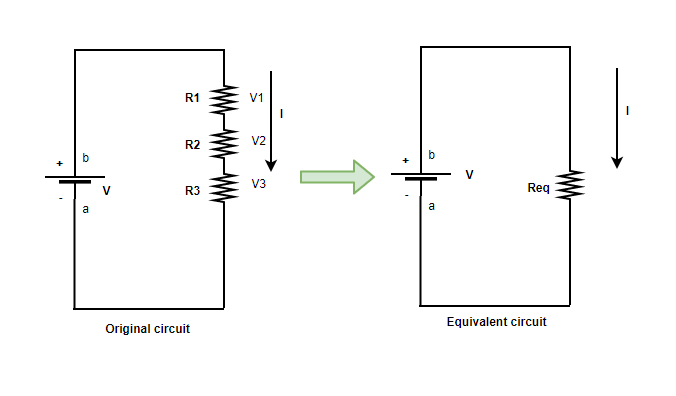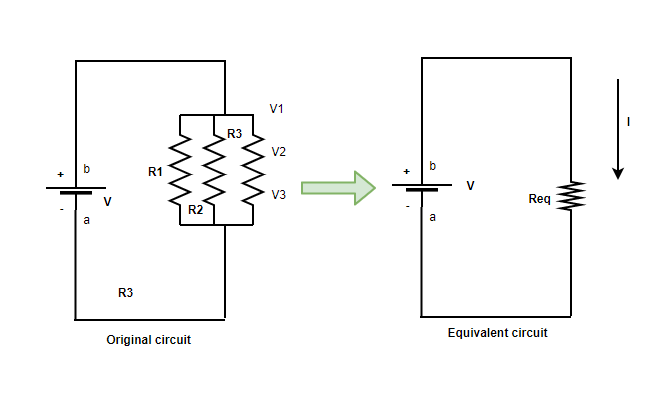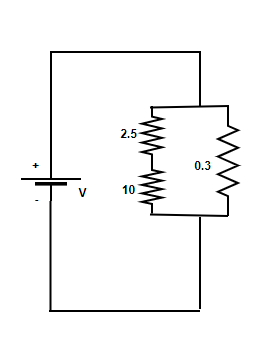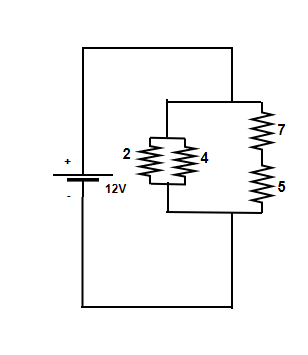电阻组合问题
电阻器是对电流提供电阻的器件。在我们的日常生活中,我们的设备在电路中有不止一个电阻。研究不同电阻排列的影响及其对电路的影响变得至关重要。通常在实际情况下,需要计算整个电路或有时部分电路所需的电阻。在这种情况下,计算等效电阻的知识会很有用,让我们详细了解这些概念。
电阻器和电阻
电阻器是限制电路中电流流动的电气设备。它是一种欧姆器件,这意味着它遵循欧姆定律 V = IR。大多数电路只有一个电阻器,但有时电路中可以存在多个电阻器。在这种情况下,流过电路的电流取决于组合的等效电阻。这些组合可以任意复杂,但可以分为两种基本类型:
- 系列组合
- 并联组合
系列组合
在下图中,三个电阻与电压为 V 的电池串联。在这些类型的组合中,电阻通常以一个接一个的顺序连接。通过每个电阻的电流是相同的。右图显示了三个电阻的等效电阻。在电阻串联组合的情况下,等效电阻由各个电阻的代数和给出。

令 V 1 、V 2和 V 3为所有三个电阻上的电压。众所周知,流过它们的电流是相同的。
V = V 1 + V 2 + V 3
展开方程,
红外 = 红外1 + 红外2 + 红外3
R = R1 + R2 + R3
并联组合
在下图中,显示了三个电阻器,它们与电压为 V 的电池并联。在这种连接中,电阻器通常连接在源自公共点的平行导线上。在这种情况下,通过每个电阻的电压是相同的。右图显示了三个电阻的等效电阻。

给定电路的等效电阻为,
![]()
In general for resistors R1, R2, R3,
![]()
示例问题
问题1:串联6、10、20欧三个电阻。求系统的等效电阻。
回答:
The formula for series resistance is given by,
R = R1 + R2 + R3
Given: R1 = 6, R2 = 10 and R3 = 20
substituting these values in the equation,
R = R1 + R2 + R3
⇒ R = 6 + 10 + 20
⇒ R = 36 Ω
问题2: 1、1、2欧三个电阻并联。求系统的等效电阻。
回答:
The formula for parallel resistance is given by,
![]()
Given: R1 = 1, R2 = 1 and R3 = 2
substituting these values in the equation,
![]()
⇒ ![]()
⇒ ![]()
⇒ ![]() Ω
Ω
问题 3:求下图所示系统的等效电阻。

回答:
The formula for parallel resistance is given by,
![]()
and the formula for series resistance is given by,
R = R1 + R2 + R3 + ….
This is combination of both parallel and series capacitances.
substituting these values in the equation,
R1 = 10 μF ,R2 = 2.5 μF
R= R1 + R2
⇒ R = 10 + 2.5
⇒ R = 12.5
![]()
⇒ ![]()
⇒ ![]()
⇒ ![]() Ω
Ω
问题 4:求下图所示系统的等效电阻:

回答:
The formula for parallel resistance is given by,
![]()
and the formula for series resistance is given by,
R = R1 + R2 + R3 + ….
This is combination of both parallel and series capacitances.
substituting these values in the equation,
R1 = 100 μF ,R2 = 25 μF
R= R1 + R2
⇒ R = 100 + 25
⇒ R = 125 Ω
![]()
⇒ ![]()
⇒ ![]()
⇒ ![]() Ω
Ω
问题5:电加热器连接到电池。当另一个类似的电加热器与原来的电加热器串联时,电路的电阻如何变化?
- 抵抗力加倍。
- 阻力减半。
- 阻力保持不变。
- 阻力增加了三倍。
回答:
The component that is added to the circuit is in series. Let’s say resistance of the heater is R. It is known that in when connected series, the equivalent resistance is the algebraic sum of the individual resistances.
Rnew = R + R
⇒ Rnew = 2R
Thus, the resistance is doubled..
Answer (1).
问题 6:找出下面给出的电路的等效电阻。

回答:
For such problems, break the circuit into small problems.
The resistances 4 and 2 are in parallel, calculating the equivalent resistance of this combination.
![]()
⇒ ![]()
⇒ ![]()
⇒ ![]() Ω
Ω
The resistances 7 and 5 are in series, calculating the equivalent resistance of this,
R = R1 + R2
⇒ R = 7 + 5
⇒ R = 12 Ω
Now these two branches are in parallel, so we have a new combination of resistances of 12 and 1.33 which are in parallel.
![]()
⇒ ![]()
⇒ ![]()
⇒ R = 1.2 Ω